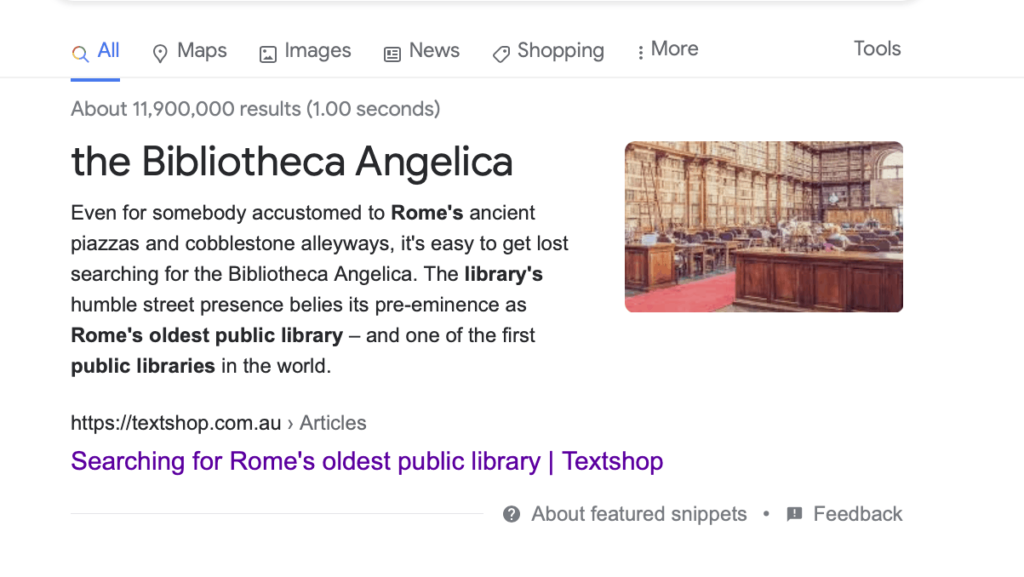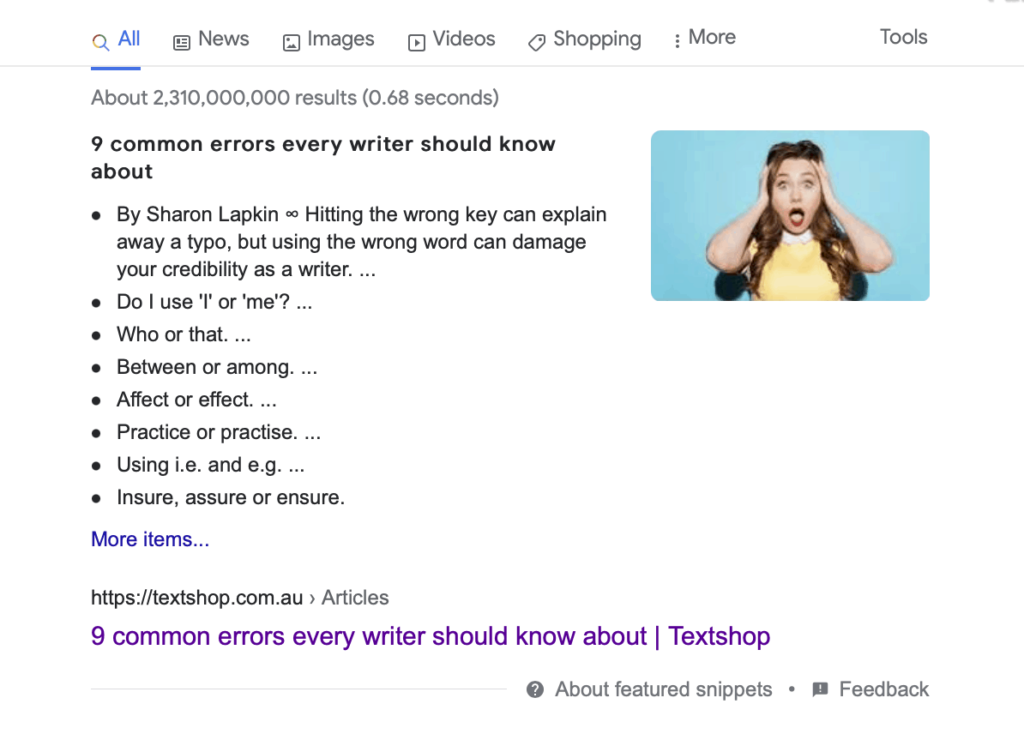So, you’re asking: Is SEO is really needed for your business?
It’s a huge YES and here’s why.
Search engine optimisation (SEO) is essential for the growth of your business and it begins and ends with your website.
SEO gets you out in front of your customers and clients, and ahead of your competitors.
If you’re clever about it and optimise your content well, your brand has a good chance of appearing in Google’s top pages when your potential clients search for goods or services.
As you’ll read below, you can even score prime Google real estate – a featured snippet at the top of page one – if you put in the work. I’ll show you how I did it more than once.
Large corporations know the answer to the question: Is SEO really needed, and they spend a lot of money manoeuvring their brands into Google’s best real estate.
But here’s the thing. You don’t need a lot of money or extra staff to get to the top of the search pages.
Is SEO really needed for your business? Absolutely yes.
With a clever strategy and staying power you can achieve great results with SEO.
Do it well and you can drive traffic to your website and grow your brand.
We still need SEO, but the procedures and methods have changed.
Keywords were once the major component of the SEO story, now they’re just one of the ways we can optimise content.
Over the years, Google has fine-tuned the tools it uses to evaluate content.
Today those tools are sophisticated and focused, and Google’s capacity to assess the quality of content is more accurate than ever.
Good SEO now requires you to focus on reading ease, image alt attributes, inbound and outbound links, text length, voice, sentence length, paragraph length, subheading distribution and more.
Don’t worry, it’s not as complicated as it sounds.
But remember that the quality and consistency of your content is important if you want to succeed.
If you publish good-quality, optimised content, your chances of ranking in the search engine results pages (SERPs) increases, and so do the chances you’ll be found by prospective clients or readers.
The relationship between keywords and clients is intrinsic to your SEO.
How?
Well, to generate on-target keywords, you have to work out the words that potential clients are going to type into Google.

These words are the basis for the long-tail keyword you’ll use to optimise your text, images, headings, alt text and meta.
This is called ‘search intent’, and knowing the words they’ll use to define their needs is essential to SEO success.
Ideally, you want to be on page one of the SERPs, but that’s a big ambition right?
It sure is, but with determination and hard work you can get there.
Is SEO really needed? Take a look at these organic search statistics that clearly answer the question.
Just over half (53%) of website traffic comes from organic research.
Almost one third of consumers in the US search for local businesses daily.
Almost 99% of people click on one of the 10 links in the first page of the SERPs.
Over 25% of people click the first Google search result.
Now, let’s look at how to optimise your content step by step.

You’ve probably seen featured snippets in Google when you search for something. They’re at the top of page one, are often large and sometimes colourful.
Seriously, you can’t buy this type of prime Google real estate.
Below are two featured snippets from my blog showcased by Google at the very top of page one.
Next time somebody asks: Is SEO really needed, you know the answer, right.

The blog post used by Google for a featured snippet on Bibliotheca Angelica (left) was ranking at position two on page one for my keyword.
Two years later, it’s ranking number three!
The other featured snippet ‘9 common errors every writer should know about’ is drawn from a blog post that was ranking in position one on page one for my longtail keyword.
Google places featured snippets at the top of page one, so readers can find the information they’re looking for without searching further.

Ranking for a featured snippet is more valuable than ranking for number one.
It’s a golden opportunity for your blog post to get worldwide attention.
It actually pushes all the organic results further down the page.
A featured snippet provides your business with greater visibility and a massive boost to your credibility.
Often, but not always, you’re occupying Google real estate with world-famous companies and organisations.
To land a featured snippet you need to focus on question-type search queries that are based on your longtail keyword.
Featured snippets are selected by Google to answer searchers’ queries in simple straightforward ways.
Here are five ways to to create featured snippets that work:
Aim to provide in-depth meaningful answers.
Write concisely and clearly. There’s no room for fluff words.
Research the questions readers have about the topic.
Provide the best answer – use tools like this great synonym finder to access perfect words.
Write at least 40 words and no more than 50.
Long-tail keywords are groups of words or a question. They’re more specific than short-tail keywords, which are usually single words.
Short-tail keywords such as ‘laptop’ have a high search volume; whereas, long-tail keywords such as ’13-inch Apple laptop’ have a lower search volume because they’re more focused.
Long-tail keywords with less volume have less competition and are easier to rank for. They’re also more likely to convert to sales.
Think about it. Who’s closer to purchasing a laptop – the person who searched for ‘laptop’ or the one who searched for ’13-inch Apple laptop’?
Once you’ve researched and selected your long-tail keyword, insert it into the places discussed below.
Include your long-tail keyword in the title of your story or article.
Don’t place the keyword in every subheading, but ensure it goes into a few of them.
Take care not to place the keyword where it doesn’t work. Make sure it fits into the text around it.
SEO is important, but not at the expense of clarity or well-executed grammar. If your optimisation causes errors or clunky writing, then you’ll lose in the long run.
Use active voice whenever possible in your writing.
In a sentence written in active voice, the subject of the sentence is performing the action.
In passive voice, it’s the other way around. The subject receives the action.
A good tip is to always place the subject of the sentence as close as possible to the beginning of the sentence.
Once you get into the habit of writing in active voice, it will be second nature.

Active – The man smiled as he typed the final lines of his novel.
Passive: Typing the final lines of his novel put a smile on the man’s face.
An active voice makes it clear who’s taking the action in a sentence. When the subject comes before the verb, it places emphasis on the subject. This improves clarity and reduces repetition.
Publishing high-resolution (300 dpi) images on your website will dramatically slow down your page speed.
If you use low resolution (96 dpi) images, your page speed will be faster, and your readers will stick around.
To achieve the smallest files possible always compress your images.
This ensures your page speed is as fast as possible.
If you use Canva for images, there’s a ‘compress file’ function on the download tab.
You can also open a free account with Shortpixel to compress your images.
Alt text is short for ‘alternative text’ and we write this as an image tag for screen readers.
Alt text is used by people who are visually impaired. So write a clear description for these readers, but add your keyword so the alt text is optimised for SEO.
 Lastly, consider context when you add your keyword into the alt text. Adding random keywords may cause your site to be seen as spam.
Lastly, consider context when you add your keyword into the alt text. Adding random keywords may cause your site to be seen as spam.

The free Yoast SEO plugin has a good readability check that ensures content is easy to read.
Yoast uses the Flesch reading ease formula to analyse two characteristics of good writing:
First, it analyses how the number of words relate to the number of sentences.
Second, it analyses how the number of syllables relate to the number of words.
These checks examine sentence length and word difficulty.
Ease of reading is also achieved by keeping sentences concise and limiting difficult words.
Keeping it simple and easy to read increases the likelihood that readers will understand the content.
To learn more about writing SEO blog posts read How to write a smashing blog post.
If you’re still wondering whether you should set up a blog for your business take a look at Does my business need a blog?
And if you want to understand the connection between SEO and content marketing, check out Is content marketing worth it?
Sharon is a content writer and award-winning editor. After acquiring two masters degrees (one in education and one in editing and comms) she worked in the publishing industry for more than 12 years. A number of major publishing accomplishments came her way, including the eighth edition of Cookery the Australian Way (more than a million copies sold across its eight editions), before she moved into corporate publishing.
Sharon worked in senior roles in medical colleges and educational organisations until 2017. Then she left her role as editorial services manager for the corporate arm of a university and founded Textshop Content – a content writing and copyediting agency that provides services to Australia’s leading universities and companies.
